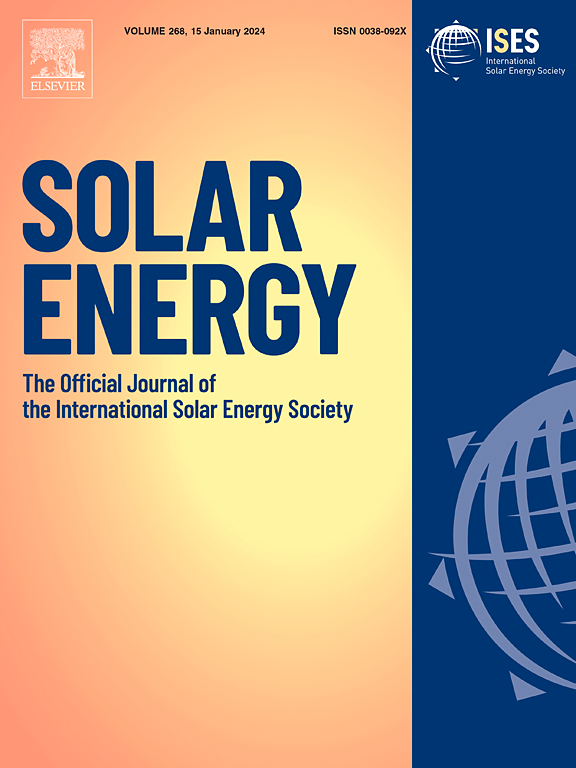通过光伏/热膜混合蒸馏实现可持续海水淡化:开发离网原型
IF 6
2区 工程技术
Q2 ENERGY & FUELS
引用次数: 0
摘要
全球淡水匮乏是一个严峻的挑战,在澳大利亚偏远社区尤为严重,海水入侵和含水层盐碱化加剧了对替代水资源的需求。传统的海水淡化技术能耗高,不适合农村地区。本研究介绍了一种利用太阳能集成膜蒸馏(MD)技术的新型离网可持续海水淡化解决方案。我们设计并开发了一种创新的独立原型,将光伏/热能(PV/T)混合系统与直接接触式膜蒸馏(DCMD)相结合。这种完全集成的 PV/T 集热器能有效地提供 MD 过程所需的热能和电能。光伏电池板产生必要的电能,而光伏电池板的热量可加热 MD 系统的进料溶液,通过太阳能电池冷却效应提高整体效率。此外,还设计并定制了一种创新的风扇冷却散热器,配备两个低功耗直流风扇,作为 MD 系统的室外冷却介质。通过全面的实验研究,采用创新和实用的方法设计和检验了集成式混合太阳能 MD 单元,详细探讨了系统的概念开发和可行性。在墨尔本夏季的动态室外条件下,对这一独特的系统进行了设计、建造和测试,以评估其集成策略和长期运行性能。在各种室外条件和 PV/T 流体流速下,使用两种不同孔径的商用疏水膜对集成 PV/T-MD 系统的性能进行了评估。分析的关键性能指标包括太阳辐照强度、PV/T 面板和 MD 模块的温度曲线、单元组件的功率、电流和电压曲线、渗透通量、比水生产力(SWP)、热效率(ηthermPV/T)和电效率(ηelecPV/T)以及增益输出比(GOR)。在室内和室外环境中进行了全面的实验评估,以确认系统的技术可行性。这项研究通过实际试验证明了此类系统的可行性,并解决了能效和内部热回收方面的关键难题。实验证明,室外的渗透通量值为 8-16 千克/平方米小时,而室内为 22-30 千克/平方米小时,这反映了环境条件波动的影响。据测量,该系统的耗电量为 130-140 瓦,约为 PV/T 额定功率的三分之一。在电池充电模式下,最大发电量达到 280 W,最大 ηthermPV/T 为 20%,ηelecPV/T 为 18%。此外,PV/T 面板的冷却效果使温度降低了 1.5-2 °C,使电力输出提高了 0.8-1.2 %。研究结果凸显了该系统在为偏远的离网社区提供可靠、高效的淡水生产方面的巨大潜力,为应对全球水资源短缺的挑战提供了一个可扩展的解决方案。本文章由计算机程序翻译,如有差异,请以英文原文为准。
Sustainable desalination through hybrid photovoltaic/thermal membrane distillation: Development of an off-grid prototype
Global freshwater scarcity is a critical challenge, particularly severe in remote Australian communities where seawater intrusion and aquifer salinisation exacerbate the need for alternative water resources. Conventional desalination technologies are energy-intensive and unsuitable for rural areas. This study introduces a novel, off-grid, sustainable desalination solution utilising solar-integrated membrane distillation (MD) technology. An innovative, stand-alone prototype combining a hybrid photovoltaic/thermal (PV/T) system with direct contact MD (DCMD) has been designed and developed. This fully integrated PV/T collector efficiently supplies the thermal and electrical energy required for the MD process. The photovoltaic panel generates the necessary electrical energy, while the heat from the PV panel warms the MD system’s feed solution, enhancing overall efficiency through the solar cell cooling effect. In addition, an innovative fan-cooled radiator equipped with two DC fans with a low power consumption rating was designed and customized to be applied as MD system cooling medium within the outdoor setting. The concept development and feasibility of the system are explored in detail through a comprehensive experimental investigation employing an innovative and practical approach to design and examine the integrated hybrid solar MD unit. This unique system was designed, constructed, and tested under dynamic outdoor conditions, during the summer season in Melbourne, to assess the integration strategy and evaluate its long-term operational performance. The performance of the integrated PV/T-MD system was evaluated using two commercial hydrophobic membranes with different pore sizes under various outdoor conditions and PV/T fluid flow rates. Key performance metrics analysed include solar irradiance intensity, temperature profiles of the PV/T panel and MD module, power, current and voltage profiles of the unit components, permeate flux, specific water productivity (SWP) and the thermal (ηthermPV/T) and electrical (ηelecPV/T) efficiencies, along with the gained output ratio (GOR). Comprehensive experimental assessments in indoor and outdoor settings were undertaken to confirm the technical viability of the system. The study demonstrates the feasibility of such systems through real-world trials and addresses key challenges in energy efficiency and internal heat recovery. The experimental trials demonstrated permeate flux values ranging between 8–16 kg/m2h outdoors, compared to 22–30 kg/m2h indoors, reflecting the impact of fluctuating environmental conditions. The system’s power consumption was measured 130–140 W, about one-third of the PV/T power rating. The maximum power generation reached 280 W in battery charging mode. achieving a maximum ηthermPV/T of 20 % and an ηelecPV/T of 18 %. Additionally, the cooling effect of the PV/T panel resulted in a 1.5–2 °C temperature reduction, improving electrical power output by 0.8–1.2 %. The findings highlight the significant potential of the system in providing reliable and efficient freshwater production in remote, off-grid communities, offering a scalable solution to address global water scarcity challenges.
求助全文
通过发布文献求助,成功后即可免费获取论文全文。
去求助
来源期刊

Solar Energy
工程技术-能源与燃料
CiteScore
13.90
自引率
9.00%
发文量
0
审稿时长
47 days
期刊介绍:
Solar Energy welcomes manuscripts presenting information not previously published in journals on any aspect of solar energy research, development, application, measurement or policy. The term "solar energy" in this context includes the indirect uses such as wind energy and biomass
 求助内容:
求助内容: 应助结果提醒方式:
应助结果提醒方式:


